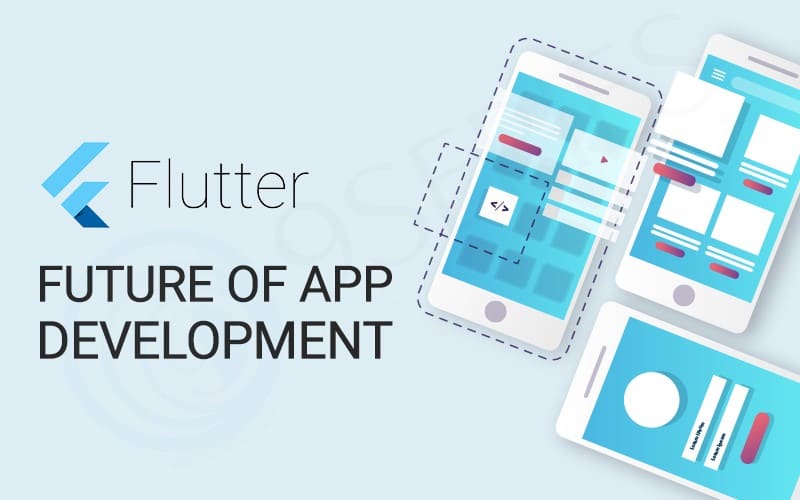Why is Flutter the Future of Cross-Platform App Development?
Flutter has grown in popularity among developers and organisations due to the many advantages of cross-platform development, such as reduced costs, consistent user experiences across platforms, a single codebase, and so on. Even cross-platform technologies like React Native, Xamarin, Cordova, Appcelerator, etc. are now available to the user base. Google’s Flutter is the true show-stopper. Since its formal introduction in 2018, it has been a free and open-source cross-platform technology. Apps like Xianyu from Alibaba and Google Ads are among its most popular clients.
To build mobile applications, developers use an SDK (Software Development Kit) provided by the operating system’s vendor. Programming languages provided by the operating system will also play a role in these SDKs. For example, Objective-C and Swift are the chosen programming languages for iOS, whereas Java is the language of choice for Android. The term “native app” refers to software developed using the platform’s official SDK and written in the platform’s chosen language. Even though we utilise the same language to construct applications for all platforms in cross-platform app development, it’s a little more complicated. Is there a way to construct cross-platform applications without the use of these favoured languages and official SDKs? Well, this is where APIs (application programming interfaces) from the native SDK come into play. This makes it easier to develop applications in languages other than those supported by the operating system. In order to build a uniform API on top of native SDKs, a vendor may use any available programming language. A single code base may be used to support many operating systems thanks to the use of this common API. An IDE for this style of programming will also be provided by the manufacturer.
Performance.
When considering cross-platform technology, one of the most important issues is whether it can achieve the same level of performance as native applications. Even while the performance gap between the two is still rather large, Flutter has made substantial progress in closing it. It’s becoming more difficult to tell the difference between a Flutter app and a native app.
User Experiences That Are Aesthetic
Having a well-designed user interface is a big advantage for mobile applications. In this regard, native applications have a distinct advantage over their cross-platform counterparts. Flutter has a broad variety of stunning widgets that allow you to create eye-catching interfaces. Two sets of widgets are available for both Android and iOS devices: Material Design and Cupertino. They may help save time and effort for programmers.
Cross-platform app development’s appeal may be attributed in large pa rt to the fact that it uses a single codebase for all supported platforms. The development process is sped up, and the same team works on all the different versions. Flutter’s hot reload functionality takes it to the next level. With hot reload, developers may immediately see the results of their changes. In this way, you are able to see your changes in the code without having to refresh the whole programme. An enormous amount of time is saved as a result of this.
Takes Mobile to the Next Level
Flutter isn’t only for smartphones and tablets. As of now, Flutter is available on both desktop and mobile platforms. Thanks to new upgrades, it is now feasible to execute Flutter apps on browsers without making any modifications to the code. During Google’s I/O conference, this capability was shown in a preview of the Flutter web. A comprehensive cross-platform app development technique is now possible thanks to this.
The Flutter User Groups
Flutter offers a vibrant community of developers that work together and share their best work. They have a significant impact on its expansion. The Flutter library offers dozens of plugins made by the community and Google engineers that you can access easily. You’ll always be able to get a response from one of them since they’re constantly online.
Numerous aspects need in-depth investigation and conversation with your development team before making a final decision on the best technology to use. One of the most popular cross-platform mobile app development technologies is Flutter. It stands out from the competition thanks to a wealth of useful features and a user interface that seems nearly organic in its design.
Why and Where to Learn Flutter?
Flutter developers are in high demand in the employment market since more and more people are designing native applications with Flutter. Experienced developers who have worked in the sector for many years say that Flutter is more convenient than anything they’ve ever used before. The three-month Baabtra Flutter Course is built with one goal in mind: to ensure that everyone who completes the course has the essential abilities to acquire a Flutter developer job instantly. You will be able to create native-looking Android and iOS apps with Flutter.
Flutter’s popularity is rising as more developers use it to create mobile apps and get into Flutter online training. There is a good chance that the Flutter community will come up with a better framework and take the lead. The current crop of native app development frameworks might be replaced by Flutter. The Flutter team has worked extensively since then to improve and build on the initial product.
The three-month Baabtra Flutter Course is built with one goal in mind: to ensure that everyone who completes the course has the essential abilities to acquire a Flutter developer job instantly. You will be able to create native-looking Android and iOS apps with Flutter. In addition, you’ll learn how to solve a typical interview programming issue. It’s a given that this course will teach you how to quickly construct high-quality, interactive mobile apps for iOS and Android devices, as well as how to personalise your application with rich and configurable widgets, built-in animations, and a layerable, extensible framework.

